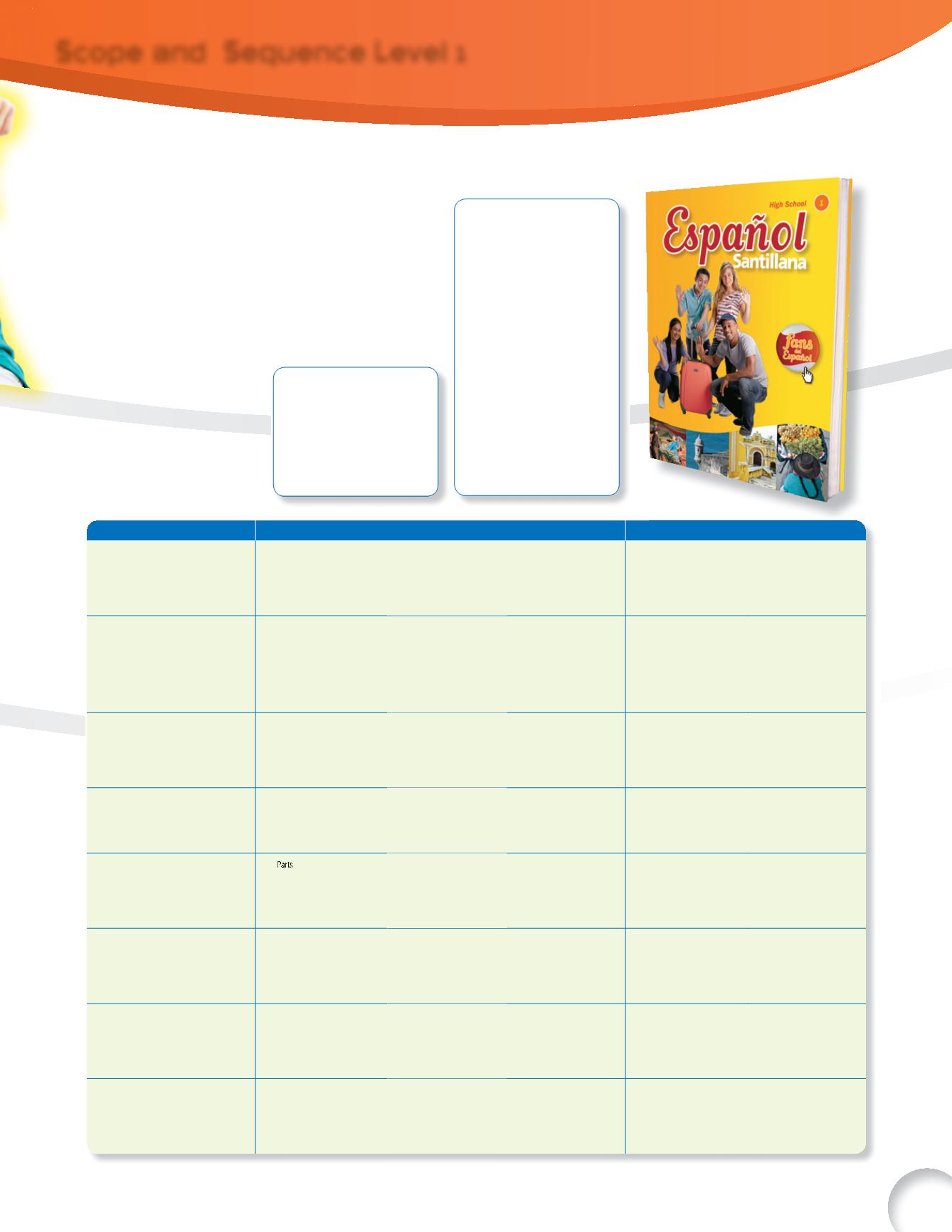

S
cope and
S
equence
17
At-a-glance look at the linguistic
and cultural concepts presented in
Levels 1–4.
S
cope and
S
equence
L
evel 1
Gramática
Cultura
•
Subject pronouns
•
The verb
ser
•
Adjectives
•
The verb
tener
•
Expressing possession:
– Possessive adjectives
–The preposition
de
•
The verb
estar
•
Mapa cultural:
Mexico
•
Mexico City: Tenochtitlan
•
The south: the indigenous
population
•
Lectura: Teotihuacán, ciudad
de los dioses
•
Nouns
•
Articles.Agreement with nouns
•
Expressing existence.
The verb
haber
•
Expressing location
•
Regular -
ar
verbs,present
tense
•
Regular -
er
and -
ir
verbs,
present tense
•
Expressing obligation:
–
Tener que
+ infinitive
–
Hay que
+ infinitive
•
Adverbs of frequency
•
Mapa cultural:
Puerto Rico
•
Old San Juan
•
Salsa, the essence of
Puerto Rico
•
Lectura: El Morro: Blog
de viajes
•
Stem-changing verbs
(e
>
ie)
•
The verb
ir
•
The verb
gustar
•
Demonstratives
•
Comparison. Comparative
adjectives
•
Stem-changing verbs
(o
>
ue)
•
Mapa cultural:
Guatemala
•
The great Mayan city ofTikal
•
The quetzal, national bird
of Guatemala
•
Lectura: Desde
Chichicastenango
•
Adverbs of quantity
•
Expressing want, preference,
and rejection.The verbs
querer
and
preferir
•
Irregular verbs in the
yo
form
•
Direct object pronouns
•
Indirect object pronouns
•
Stem-changing verbs
(e
>
i)
•
Mapa cultural:
Peru
•
The Incas, kings of the
mountains
•
The Nazca lines
•
Lectura: Festividad inca
del Inti Raymi
•
The verbs
ver
,
oír
,
oler
,
and
decir
•
Reflexive verbs
•
The verb
doler
•
The verb
sentirse
•
Affirmative
tú
commands.
Regular verbs
•
Mapa cultural
: Spain
•
Madrid: a painter’s paradise
•
The south: an arabic
heritage
•
Lectura: El
Guernica
,
de Pablo Picasso
•
Affirmative commands.
Irregular verbs
•
Ir a
+ infinitive.Time
markers in the future
•
The present progressive
•
The present participle
•
Stem-changing verbs
(u
>
ue)
•
Mapa cultural
: United States
•
Hispanic influence
in the United States
•
States with Hispanic history
•
Concentration of Hispanic
people in cities
•
Lectura
:
Celebramos
la Herencia Hispana
•
The preterite tense of regular
-
ar
verbs
•
The preterite tense of regular
-
er
and -
ir
verbs
•
Time markers in the past
•
The preterite tense of the
verbs
ser
and
ir
•
Negative commands
•
Mapa cultural
: Argentina
•
The tango
•
Buenos Aires
•
Lectura
:
La vuelta al mundo
de Cinthia Scoch
•
Expressing cause:
porque
and
por
•
Expressing quantity.Indefinites
•
Irregular verbs in the
preterite.
Decir
and
hacer
•
Irregular verbs in the
preterite.
Estar
and
tener
•
Expressing permission and
prohibition
•
Mapa cultural
: Chile
•
Easter Island
•
Pablo Neruda
•
The chinchineros
•
Lectura
:
Oda a la manzana
Unidad
Vocabulario
Unit 1
México
30–85
•
People
•
Physical characteristics
•
Personality traits
•
Family
•
States and conditions
Unit 2
Puerto Rico
86–143
•
The house
•
Furniture and objects in a
house
•
Household chores
•
Leisure activities
Unit 3
Guatemala
144–199
•
The shopping center
•
Clothing and footwear
•
Describing clothing and
footwear
•
Shopping
Unit 4
Perú
200–255
•
Foods and beverages
•
Food stores
•
At the table
•
Describing food
Unit 5
España
256–309
•
of the body
•
Personal hygiene
•
Symptoms and illnesses
•
Basic remedies
•
Healthy habits
Unit 6
Estados Unidos
310–363
•
The world of work
•
Hobbies
•
Free time
•
Sports
Unit 7
Argentina
364–417
•
Transportation
•
Travel
•
Destinations and lodging
•
The city.Location and
directions
Unit 8
Chile
418–471
•
The universe
•
Geography
•
Political divisions
•
Numbers from 101 to 1,000
•
Nature and the environment
Preliminary
Unit
Primeros pasos
1–29
•
Spelling and pronouncing words
in Spanish ............................................. 2
•
Greetings and introductions .................. 4
•
Goodbyes and courtesy
expressions ............................................. 6
•
The classroom ......................................... 8
•
Useful classroom expressions ............. 10
•
Asking questions ................................. 12
•
Days and dates ................................... 14
•
The school schedule ........................... 16
•
Weather and seasons ........................... 18
•
Three reasons to learn Spanish ........... 20
•
Spanish around the world ................... 22
•
Learning strategies ............................... 24
•
Review ................................................ 28
Contents
Appendices
R1–R50
•
Grammar summary ............................R1
•
Spanish-English glossary ................ R14
•
English-Spanish glossary ................ R31
•
Grammar index ............................... R46



















